The Revierderby is one of the most eagerly anticipated derbies in Europe. With the fans providing an incredible atmosphere with their flags and flares, Borussia Dortmund’s Yellow Wall at the Westfalenstadion was a spectacle as the players walked out for the 99th Bundesliga Ruhr Derby. 1,057 days since the last Revierderby with full fan capacity, Borussia Dortmund came out on top to beat Schalke 04 1-0.
Prior to the derby, Dortmund experienced a week of suffering. Last weekend’s 3-0 loss at RB Leipzig against their former manager Marco Rose was an abysmal performance, with BVB unable to cope with their opponent’s high pressure and verticality and failing to muster a shot on target for the first time in three years. Travelling to Premier League champions Manchester City on matchday two of the UEFA Champions League, Edin Terzić deployed a different approach.
With a much more defensive 4-3-3, utilising the central midfielders to drop and control the half-spaces alongside City’s underlapping runs, Dortmund took the lead with a Jude Bellingham header from the second phase of a corner. However, Terzić undid BVB’s hard work with one major substitution. By bringing in Nico Schlotterbeck to shift into a 3-4-3, Dortmund couldn’t put pressure on the ball on the edge of the box and allowed City to have a 2vs1 in wide areas. Pep Guardiola’s side punished Terzić, with goals from John Stones and former Dortmund superstar Erling Haaland.
Schalke, on the other hand, had just picked up their first win of the Bundesliga campaign with a 3-1 victory against VfL Bochum. After a disastrous season ending in relegation in 2020/21, Die Königsblauen achieved a bounce-back promotion and were crowned champions of the 2. Bundesliga. Under Frank Kramer, Schalke look to be more organised than their last Bundesliga season.
In this tactical analysis, we will look at how Borussia Dortmund’s alterations overcame Schalke’s defensive structure, with the wide areas key to BVB’s penetration.
Lineups
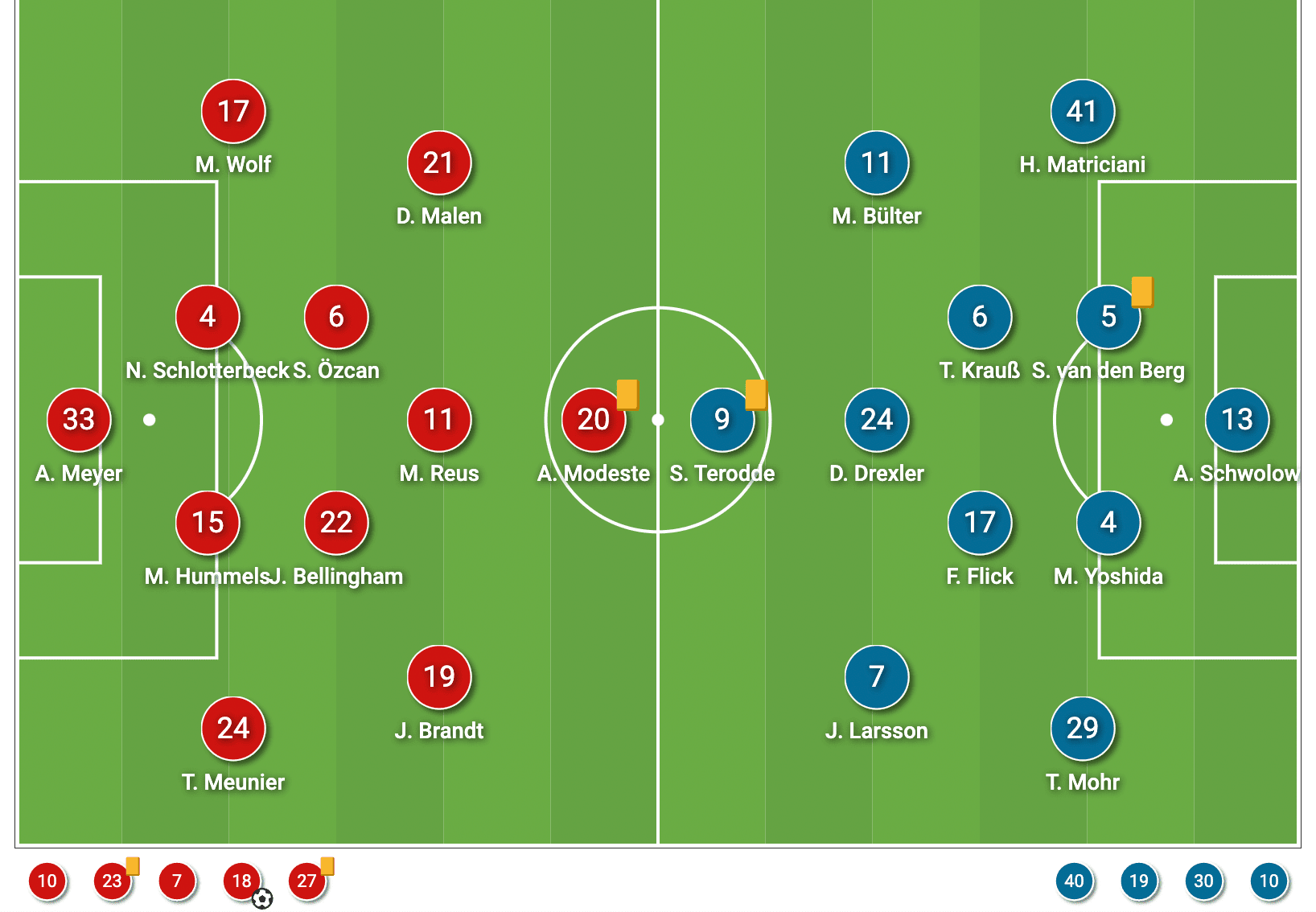
With Gregor Kobel out injured, Borussia Dortmund gave 31-year-old Alexander Meyer his second ever Bundesliga start, with his first coming in the 3-0 loss in Leipzig. The experienced Mats Hummels was partnering with German international Nico Schlotterbeck in a right and left-footed centre-back pairing. They were flanked by Belgium right-back Thomas Meunier and the impressively versatile Marius Wolf. Midfielder Salih Özcan, a summer signing from FC Köln, continued his strong performances in helping to unleash English wonderkid Jude Bellingham. Former Blackburn Rovers loanee Anthony Modeste led the line for Dortmund ahead of an attacking trio consisting of Julian Brandt, Marco Reus and the direct Donyell Malen.
Schalke were unchanged from their 3-1 win against VfL Bochum at the Veltins-Arena. With 16 first-team arrivals in the transfer window, this Schalke squad looks different to their promotion squad, especially in the defence. Hertha BSC loanee Alexander Schwolow started between the sticks behind a centre-back duo of Liverpool loanee Sepp van den Berg and Maya Yoshida, a recent arrival from Sampdoria. Henning Matriciani started at right-back for the second time in his Bundesliga career, meanwhile, Tobias Mohr was deployed at left-back, following his move after an impressive season with FC Heidenheim in the 2. Bundesliga. Florian Flick was alongside Tom Krauß in Schalke’s double pivot, with Dominik Drexler in the attacking midfield role. Captain and striker Simon Terodde was flanked by Marius Bülter and Jordan Larsson on the wings.
Substitutions have played a massive role in Dortmund’s season so far. Their loss against Manchester City followed Terzić’s move to a back three with Schlotterbeck alongside City’s substitutions being difference makers on the night. Their embarrassing loss at home against Werder Bremen from 2-0 up was triggered by Lee Buchanan, Niklas Schmidt and Oliver Burke all scoring off the bench for the away team, and was compounded by Terzić’s substitutions making no impact.
However, BVB’s 3-1 win from a goal behind at Freiburg occurred after Terzić brought on Marius Wolf, Youssoufa Moukoko and another English youngster Jamie Bynoe-Gittens, with the trio all scoring. This weekend, his substitutions won the Revierderby, with 17-year-old Moukoko being the protagonist.
A follow-through challenge on Marco Reus caused the 33-year-old to be stretchered off with an ankle sprain, potentially leaving the German international out of the 2022 World Cup in Qatar. He was replaced by USMNT youngster Giovanni Reyna in the 32nd minute, whose introduction on the right brought Julian Brandt to the central role behind Anthony Modeste. Modeste was later replaced by match winner Moukoko in a double substitution which saw dangerous Malen come off for Karim Adeyemi. After going in front, Dortmund protected their lead by bringing on Thorgan Hazard and defensive midfielder Emre Can as Brandt and Reyna came off, with Terzić looking to manage the American’s minutes after an injury-hit last season.
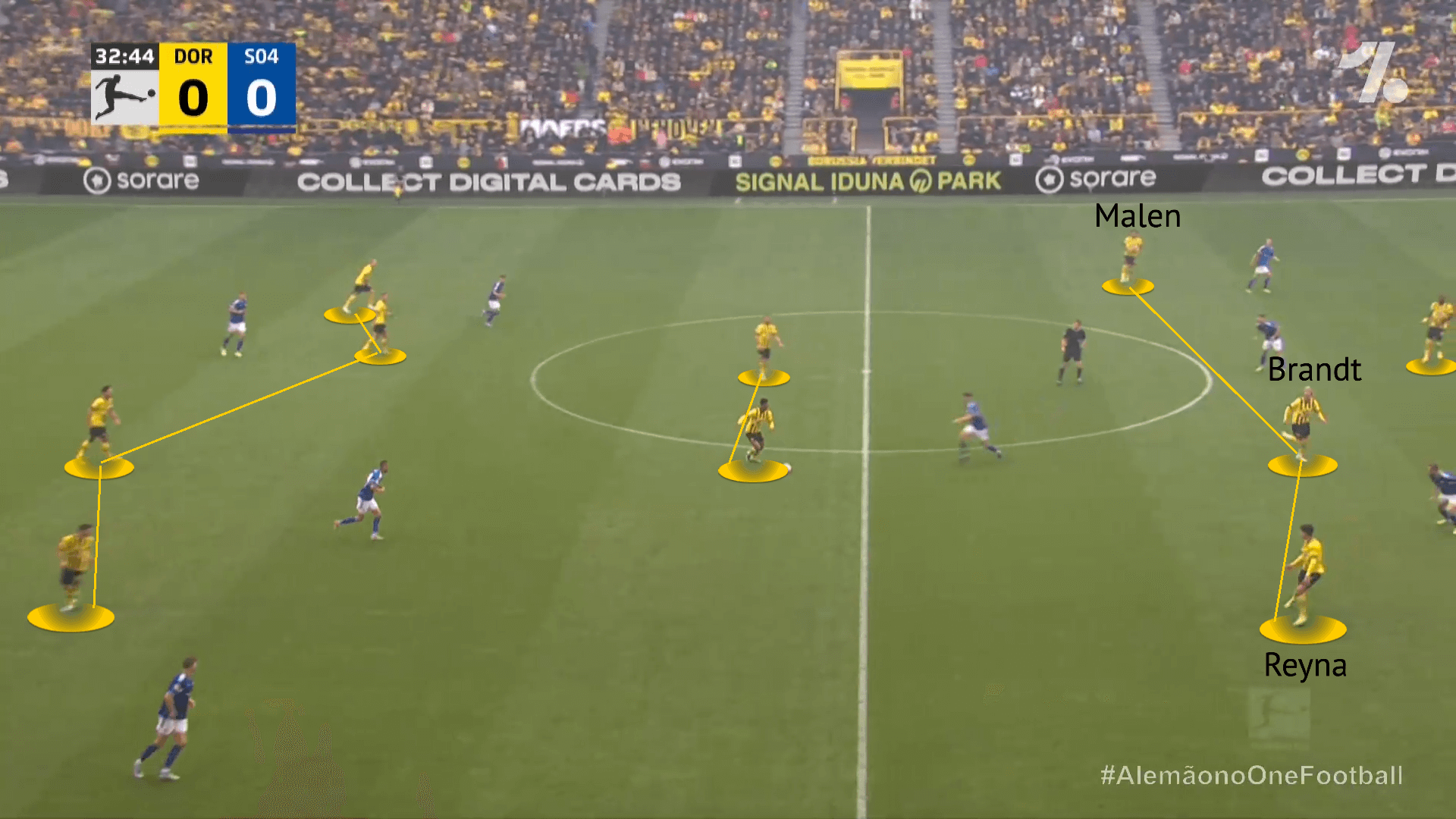
Schalke’s substitutions also made a positive impact. Target man Terodde and attacker Jordan Larsson came off in the 58th minute in like-for-like changes as Sebastian Polter and Kenan Karaman came on. Karaman had Schalke’s first and the best chance of the Revierderby, coming off the right wing to get on the end of cut-back, with his goal-bound shot blocked by Nico Schlotterbeck.
With the game still level, Frank Kramer brought on Alex Král in a more advanced role to help press BVB’s centre-backs, a far cry from the deeper role he excelled in at Spartak Moscow under Domenico Tedesco. With Dortmund scoring three minutes after the Czechs’ arrival, this change from Kramer had minimal benefits. Needing something special to get a result at the home of their fiercest rivals, Schalke turned to midfielder Rodrigo Zalazar. Zalazar displayed exceptional ball-carrying from deep and success in duels, something Schalke lacked, which resulted in the Uruguayan being fouled three times.
Schalke organisation forcing Dortmund alterations
With 67.5% possession, Borussia Dortmund controlled the ball against the resolute defensive organisation of Schalke. Dortmund’s domination is further highlighted by their field tilt of 77.6% and Schalke’s defensive line height of 34.4 metres. Despite allowing Dortmund lots of possession, with BVB completing 18 10+ pass sequences, Frank Kramer’s team were initially very well organised, forcing Dortmund to modify.
In the first half, Schalke’s out-of-possession shape of their 4-2-3-1/4-4-1-1 gave Dortmund some issues in accessing midfielder Salih Özcan. With striker Simon Terodde splitting the Dortmund centre-backs and looking to block passing lanes into Özcan, the biggest obstacle for Özcan was actually Dominick Drexler. Drexler, deployed as the ‘10’ in Schalke’s 4-2-3-1, was tasked with man-marking the Turkish international. This is a tactic RB Leipzig had success with last week, with Emil Forsberg man-marking Özcan.

In the image above, we can see Drexler man-marking Özcan in Dortmund’s 2-1 build-up. With Jude Bellingham looking to advance and occupy spaces between the lines, the two teams similar shapes made the defensive roles of Schalke’s players easier. As Terrode and Drexler are helping to force the ball wide, Mats Hummels finds right-back Thomas Meunier.
Dortmund’s full-backs are typically their primary outlets and can be key progressive threats as receivers, but Schalke used the touchline constraint well, particularly against Meunier. In the initial phases of construction, Dortmund’s full-backs are less involved and often operate higher to create a 2-1-7 type of shape, with the wingers inverting. One full-back has occasionally dropped deep to receive shorter passes to then progress the ball forward in recent games. However, this responsibility is better suited to Raphaël Guerreiro, the injured left-back, rather than Meunier.
In the image below, Schalke have deployed a man-oriented press after Hummels played the ball wide to Meunier. With Julian Brandt attempting to occupy Schalke left-back Tobias Mohr, he is unable to receive a pass, forcing Meunier to either carry the ball forwards or turn back. Jordan Larsson’s deeper positioning in the midfield unit means he can press out towards Meunier to prevent progression and force play backwards.
Schalke’s man-oriented press stops Bellingham from becoming a passing option due to Florian Flick. Meanwhile, Drexler continues to follow Özcan and striker Terodde also prevents the safest pass into Hummels. Combative midfielder Tom Krauß is occupying spaces between the lines for Schalke, helping to shield ahead of the defence. Schalke fan Krauß has started the season well as one of the best defensive duellers in the Bundesliga. With Meunier short of options, the Belgian international plays a risky pass across to left-sided centre-back Nico Schlotterbeck.
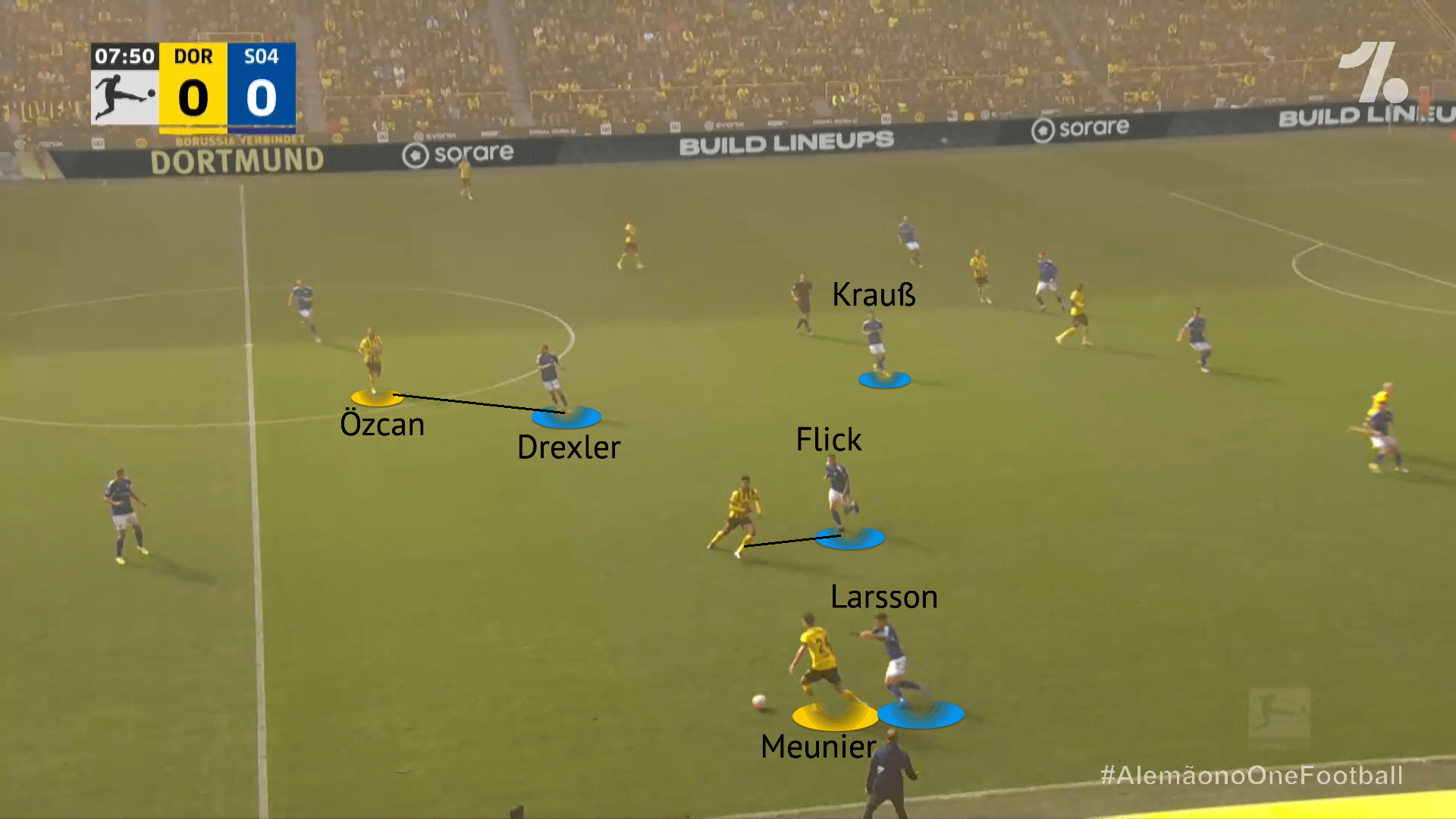
Despite having a 2vs1 with the centre-backs against Terodde, Edin Terzić had to modify Dortmund’s build-up for better ball progression. BVB needed another player in the deeper areas to alleviate Drexler’s positioning in the pivot space. The Black and Yellow had some positive moments in the first half, with Jude Bellingham receiving alongside the centre-backs and able to fire line-breaking passes forward. In the second half, this tactic was seen more frequently with Salih Özcan.
As we can see in the figure below, Özcan has split the two centre-backs. With Bellingham dropping into the pivot space and occupying Drexler, Dortmund’s build-up shape resembles a diamond. Özcan positioning between the centre-backs has dismarked the Turkish international from Drexler and facilitated the wider positioning of centre-backs Mats Hummels and Nico Schlotterbeck. This left Dortmund 3vs1 against a growingly frustrated Terodde, failing to fulfil his role as an outlet as he lost all ten of his duels. With the quality ball-playing ability of Hummels and Schlotterbeck, this increased space and time on the ball helped Dortmund’s progression in the second half.
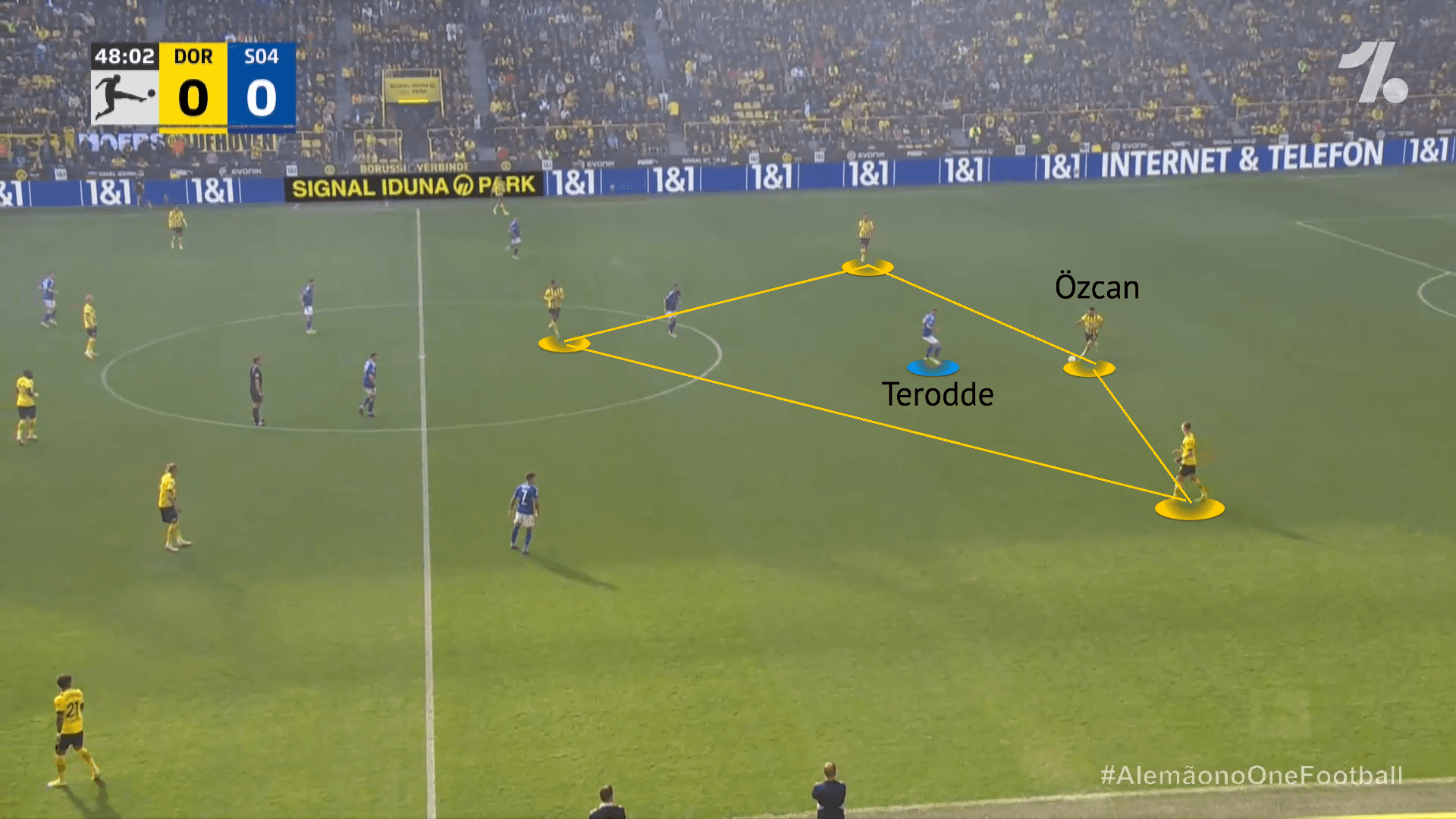
Borussia Dortmund can also create the 4vs2 overload in the build-up phase with Salih Özcan being man-marked by Dominick Drexler.
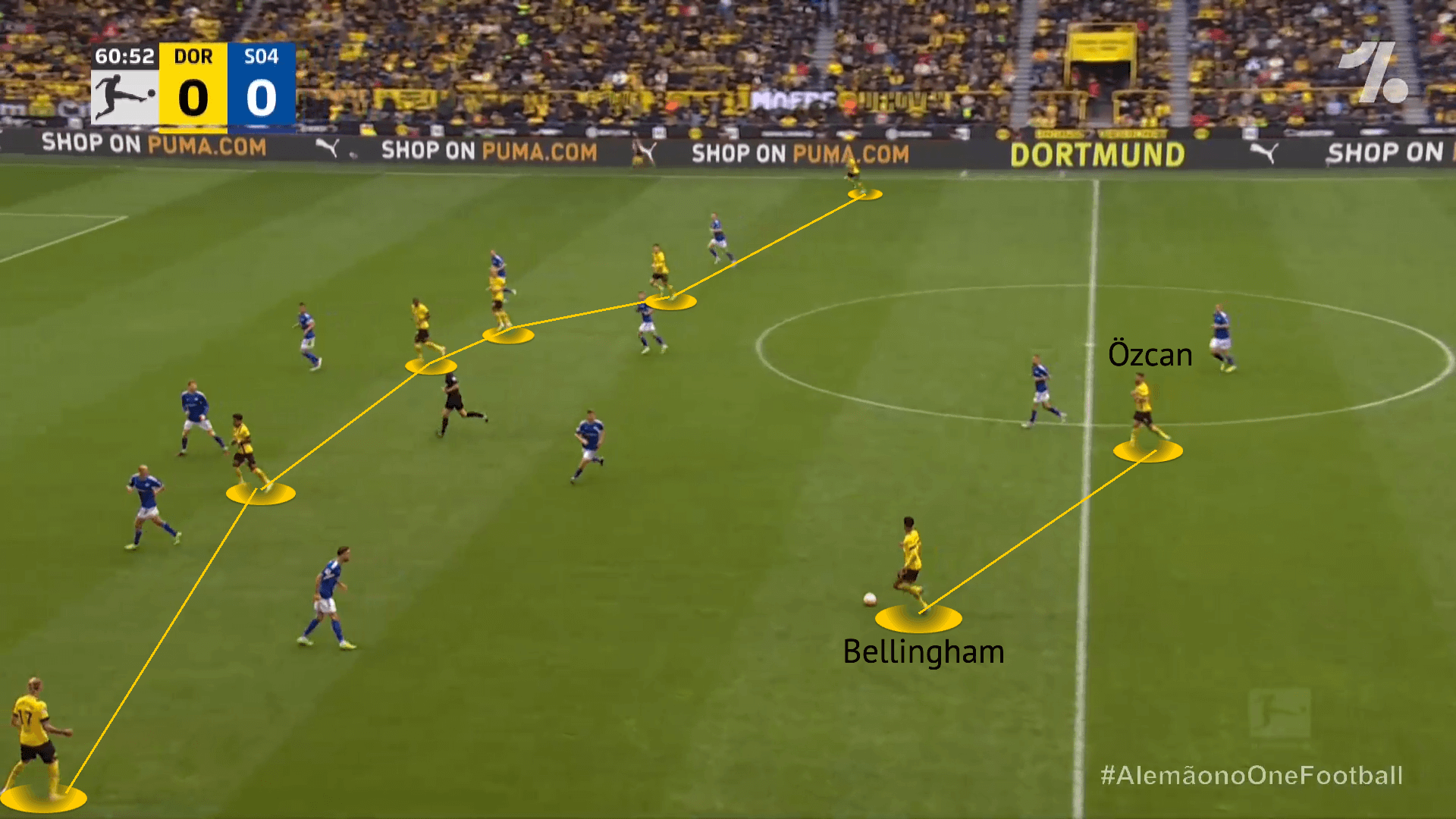
By creating the 2-2 build-up shape as shown in the two images above and below, Jude Bellingham is able to receive freely whilst Özcan is attracting opposition centrally. With full-backs Thomas Meunier and Marius Wolf advancing to operate as width holders in Dortmund’s 2-2-6 shape, they are pinning back Schalke’s wingers. By operating as width holders, Giovanni Reyna and Donyell Malen can invert into the half-spaces. Overall, Schalke’s central midfielders are restricted from pressing or following Bellingham due to perturbing the midfield line.
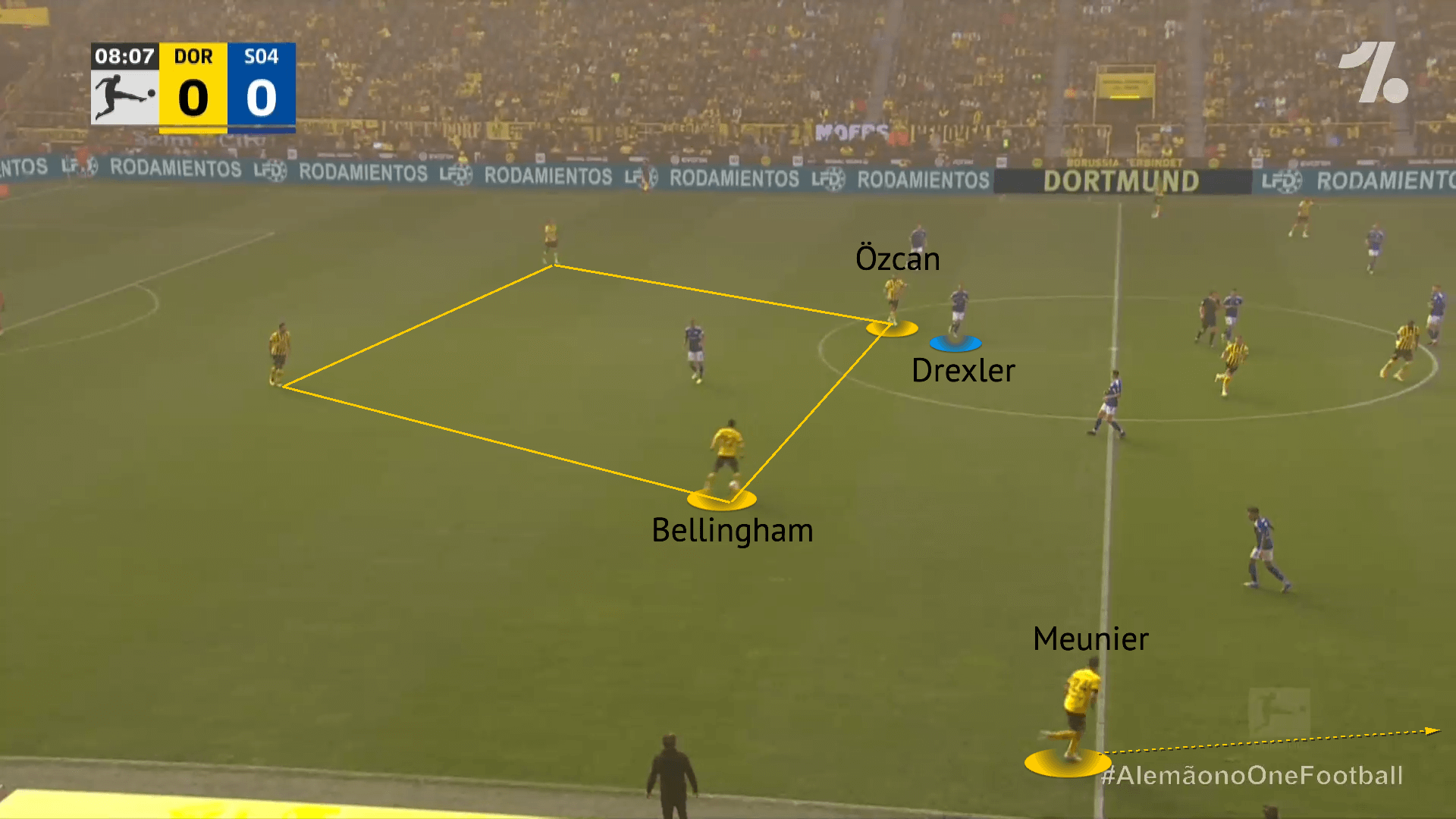
Dortmund in the wide areas
With Schalke’s central compactness to usher the ball wide alongside Borussia Dortmund’s tendency to find the full-backs, the Revierderby was naturally influenced by the wide areas. From Dortmund’s 42 positional attacks, just eight came from central areas, with 15 coming off the left wing and 19 from the right-wing. Just four of Schalke’s 18 positional attacks came from central areas as well.
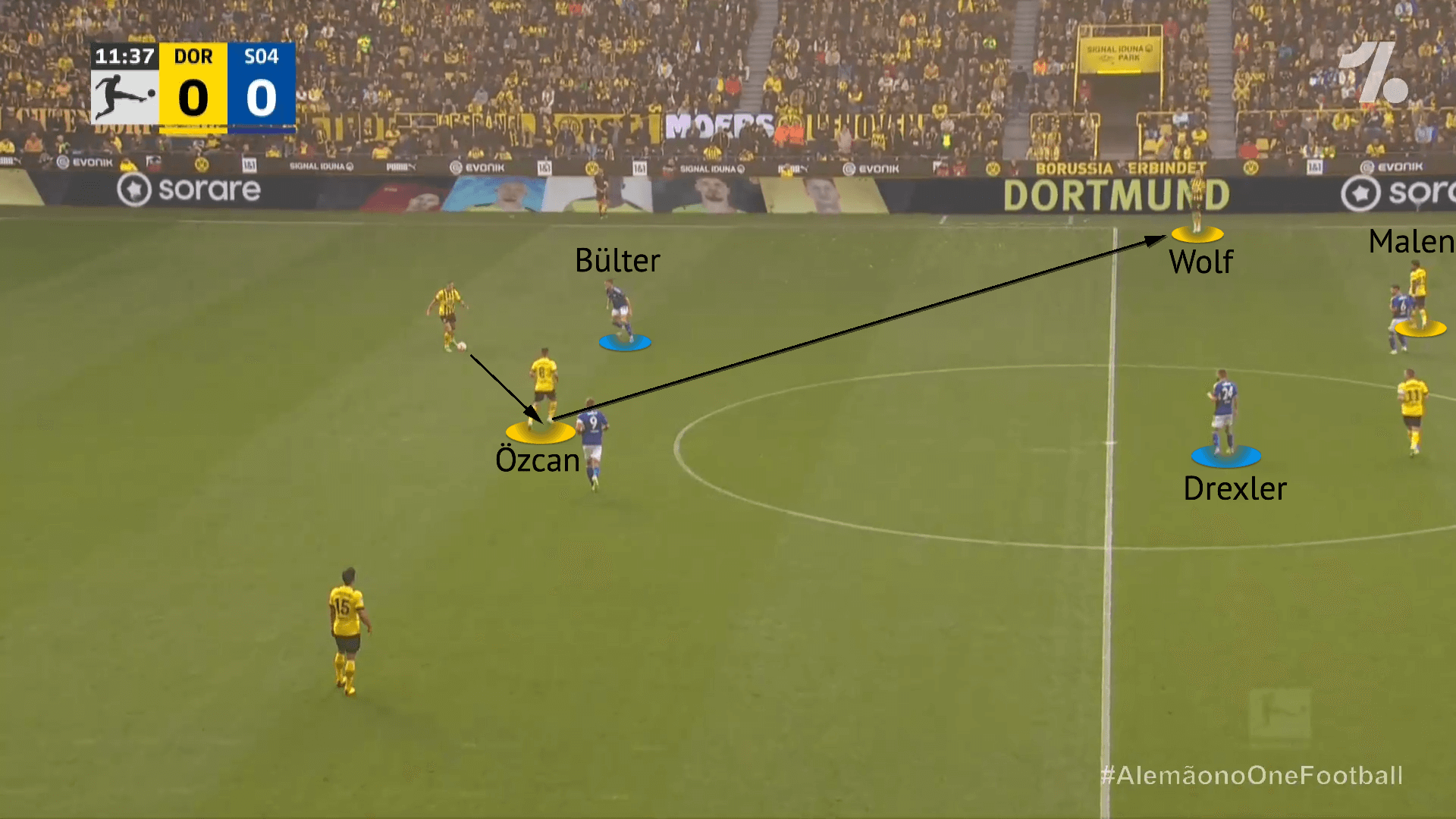
The image above displays Dortmund capitalising on one of few Schalke organisational errors in the first half. The aforementioned man-marking of Salih Özcan by Dominick Drexler is missing for Schalke, with striker Simon Terodde not preventing the pass into the Turkish international. However, the major stumbling block for Frank Kramer’s team is the actions of winger Marius Bülter. Bülter has been drawn to centre-back Nico Schlotterbeck rather than being positioned in Schalke’s midfield line next to Tom Krauß. Although Bülter is covering the passing lane from Schlotterbeck to left-back Marius Wolf, the winger is bypassed with Schlotterbeck finding Özcan to access Wolf.
With Bülter unable to press Wolf, Schalke’s right-back Henning Matriciani decides to jump out of the defensive line and close down Dortmund’s left-back. With Donyell Malen positioned in the left half-space due to Wolf’s width holder role, Malen can make a run into Matriciani’s vacated space. The former Arsenal youth player utilised his electric speed to accelerate away from Krauß and receive Wolf’s pass. Malen was able to drive at centre-back Sepp van den Berg and enter the penalty box before his cross was deflected for a corner by the Liverpool loanee.
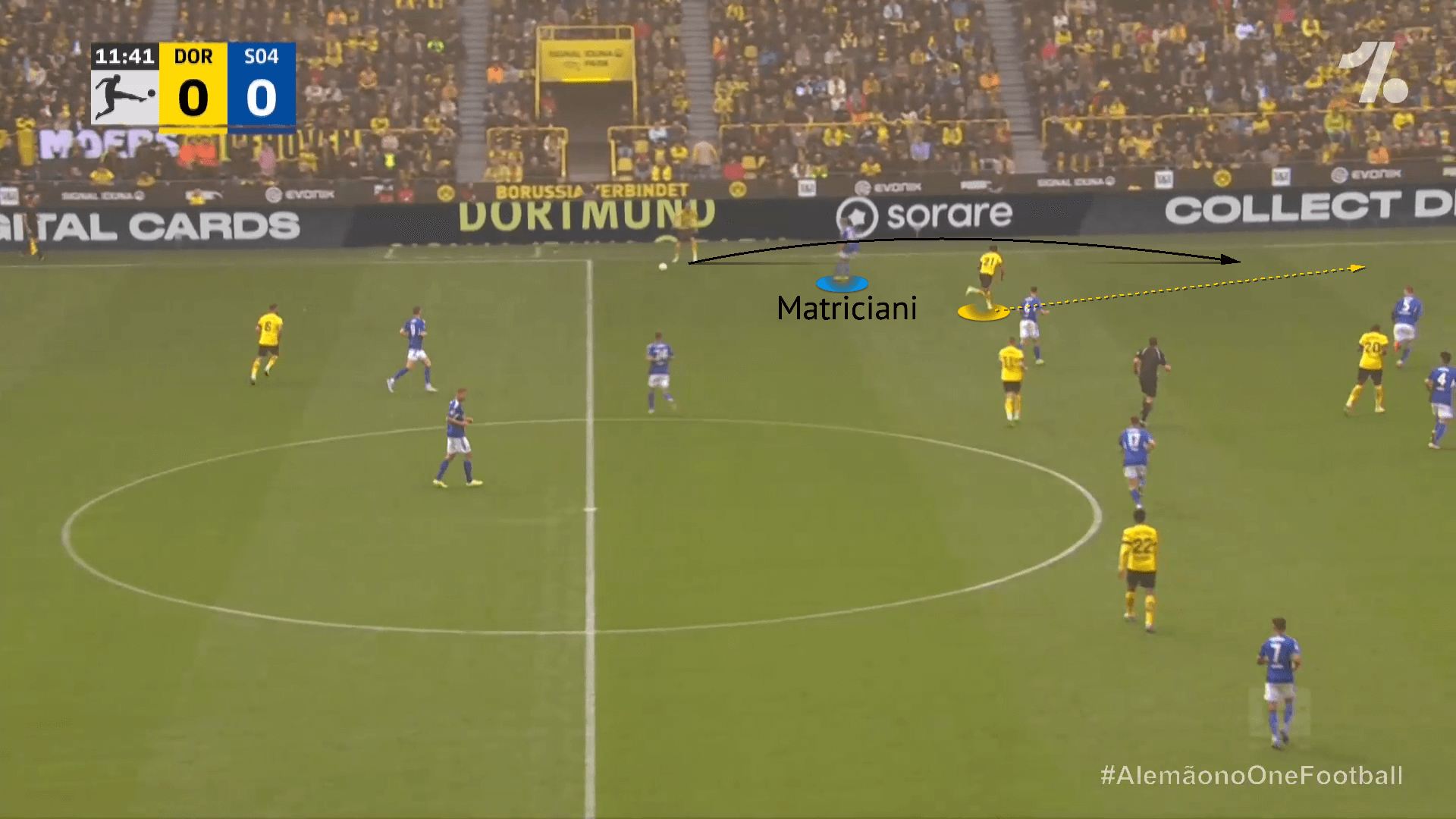
Malen was a constant threat on the left wing, able to operate wide as well as in the half-space. The Dutchman’s directness was indefensible at times for the right side of Schalke’s defence, with his frightening change of pace and dribbling. Malen completed all six of his attempted dribbles, including four progressive runs, and won eight of his ten attacking duels.
In the image below, Nico Schlotterbeck has displayed his exceptional composure in possession to bring down an aerial ball forward from Schalke. Utilising his ball-carrying that was effective last season at Freiburg, Schlotterbeck could progress and play a ball between Schalke’s right-back and right-sided centre-back for Malen to chase in behind. Malen reached the byline and delivered a cross towards the back-post for the perfectly timed run of Jude Bellingham, whose header forced a wonderful save from Alexander Schwolow.
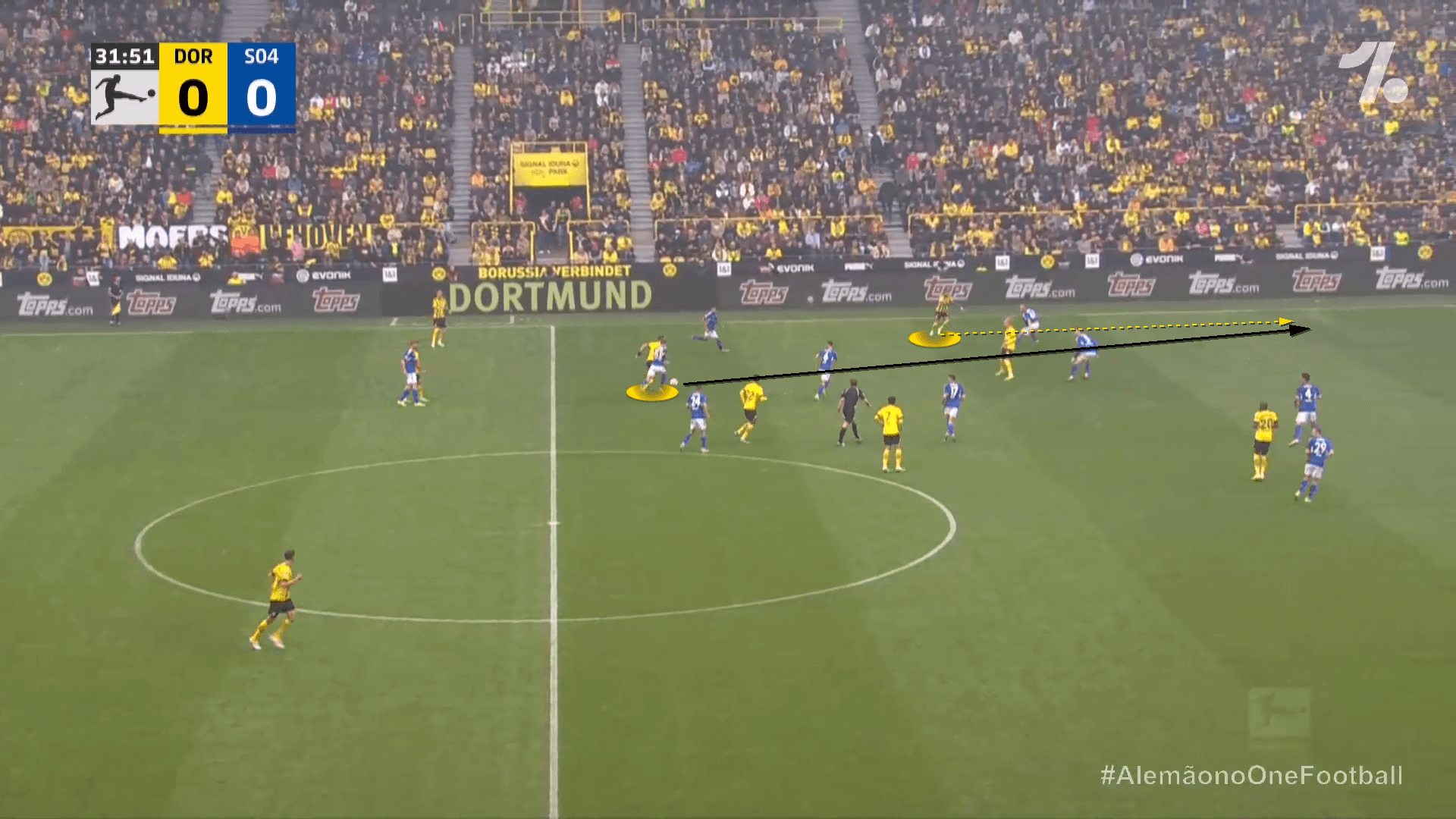
The centre-backs are crucial for Dortmund progressing the ball into wide areas in all phases, from the build-up to the final third. In most games, the centre-backs and Özcan have minimal influence as Dortmund look to penetrate in the final third, but that changed against Schalke. With Frank Kramer’s side sitting deep, Terzić was able to deploy an aggressive rest defence structure to help BVB sustain pressure and circulate possession.
In the figure below, all Borussia Dortmund outfielders are within 35 yards of the Schalke goal. Using his magnificent weight of pass, Mats Hummels lofts a pass to left-sided centre-back Nico Schlotterbeck, who can move wider due to Salih Özcan’s position between the centre-backs. With Thomas Meunier and Giovanni Reyna providing width to stretch Schalke’s block, there is a gap for Schlotterbeck to deliver a penetrative pass into Marius Wolf’s feet. The right-footed left-back was able to receive on the half-turn before firing a left-footed shot at Schalke goalkeeper Schwolow.

Nico Schlotterbeck was the best progressor on show in the Revierderby, advancing Dortmund through passing and dribbling. Mats Hummels, not so much of a dribbler, displayed his well-known long passing quality as both centre-backs attempted switches of play to move Schalke’s defensive structure. Both players found success with switching to isolated teammates or finding the wide player in situations where BVB could create an overload.
In the image below, Dortmund have circulated possession to rebuild the attack, finding the free man Schlotterbeck. With the Schalke structure naturally shuttling across, Schlotterbeck quickly gets the ball out of his feet to launch a diagonal pass to the unmarked Giovanni Reyna. The USMNT youngster was able to combine on the right wing with Thomas Meunier and Julian Brandt before a Bellingham flick went through to Schwolow.
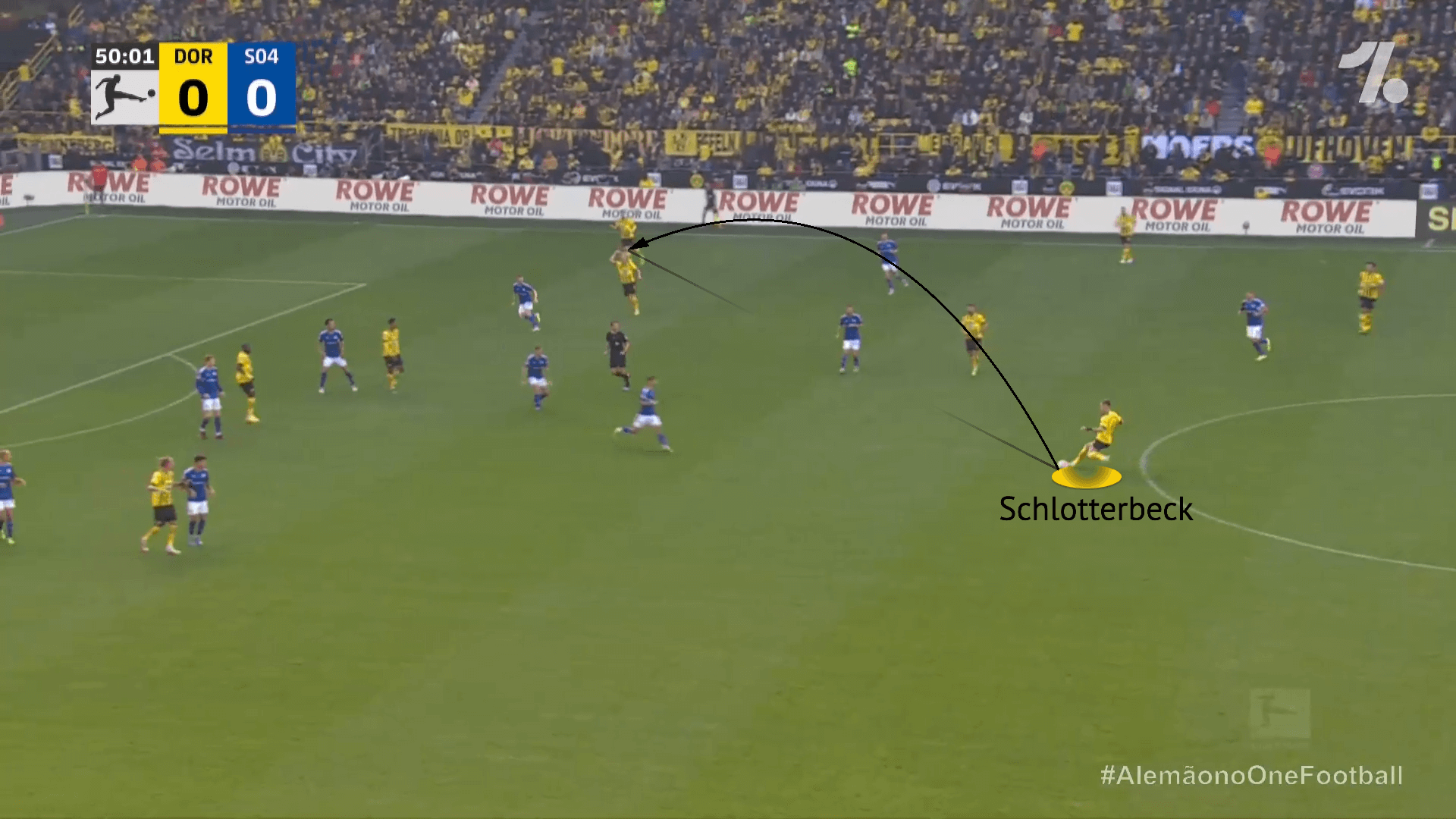
The winning goal for Borussia Dortmund has qualities from all aspects we have discussed in this tactical analysis. Giovanni Reyna is able to receive from Mats Hummels after the American became the fourth man in the 4vs2 overload against Schalke’s front line.
With Thomas Meunier operating as the right width holder, winger Karim Adeyemi is positioned in the right half-space with the nearby Julian Brandt moving freely across the attack. Marius Wolf is isolated as the left width-holder and receives the diagonal pass from Reyna. The left-back shifts the ball onto his stronger right foot to deliver a whipped cross towards the back post for 17-year-old Youssoufa Moukoko to head home the match-winner in the Revierderby.
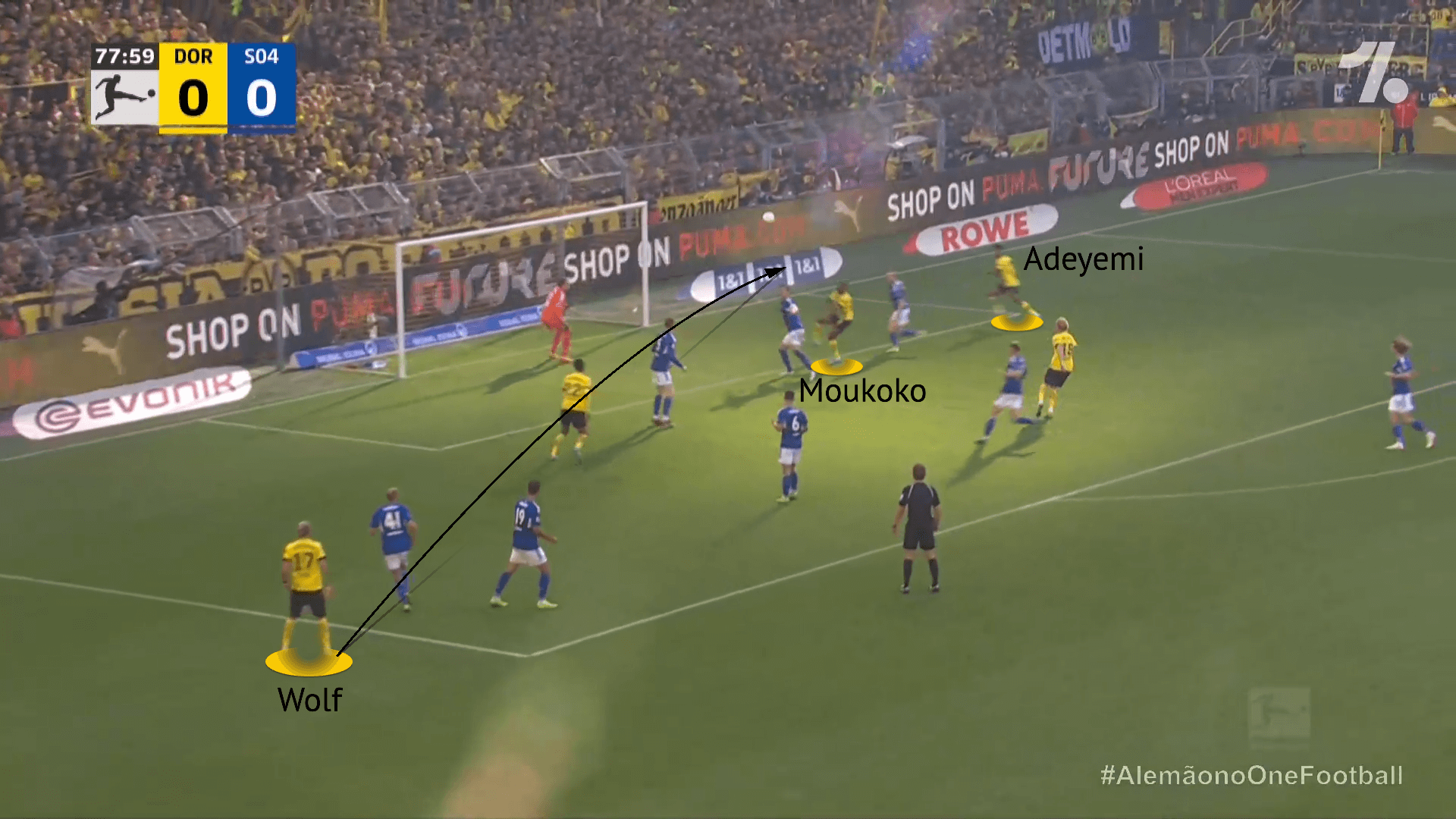
Conclusion
Despite a spirited Schalke performance defensively, Borussia Dortmund’s dominance eventually provided the only goal of the game from the wide areas. There were signs of Dortmund’s danger on the wings throughout the Revierderby, with Donyell Malen’s directness terrorising Henning Matriciani and Sepp van den Berg on the right side of Schalke’s defence. But it was right-footed left-back Marius Wolf who delivered the quality, assisting wonderkid Youssoufa Moukoko.
Edin Terzić’s plan to overcome Frank Kramer’s tactic of instructing Dominick Drexler to man-mark BVB midfielder Salih Özcan helped the Black and Yellow progress possession, utilising the brilliant ball-playing qualities of German centre-back pairing Mats Hummels and Nico Schlotterbeck. Jude Bellingham continues to impress as the next Dortmund player destined for a move to one of Europe’s superclubs.
The injury to Marco Reus is potentially heart-breaking for the German’s hopes of a World Cup spot, as it could be yet another international tournament the talented attacker misses due to injury. Initial hopes are that Reus returns towards the end of October, but it’s Hansi Flick’s decision on whether the 33-year-old will be ready.
This new-look Schalke side under Frank Kramer still needs time to gel, with their massive squad overhaul in the summer. The Royal Blues have a lot to work on going forward, relying on transitional threat against Dortmund and set-pieces from Tobias Mohr previously this season.
In this tactical analysis, we have identified how Borussia Dortmund overcame Schalke’s defensive structure and tactics as they eventually broke the deadlock from the wide area to win the Revierderby.

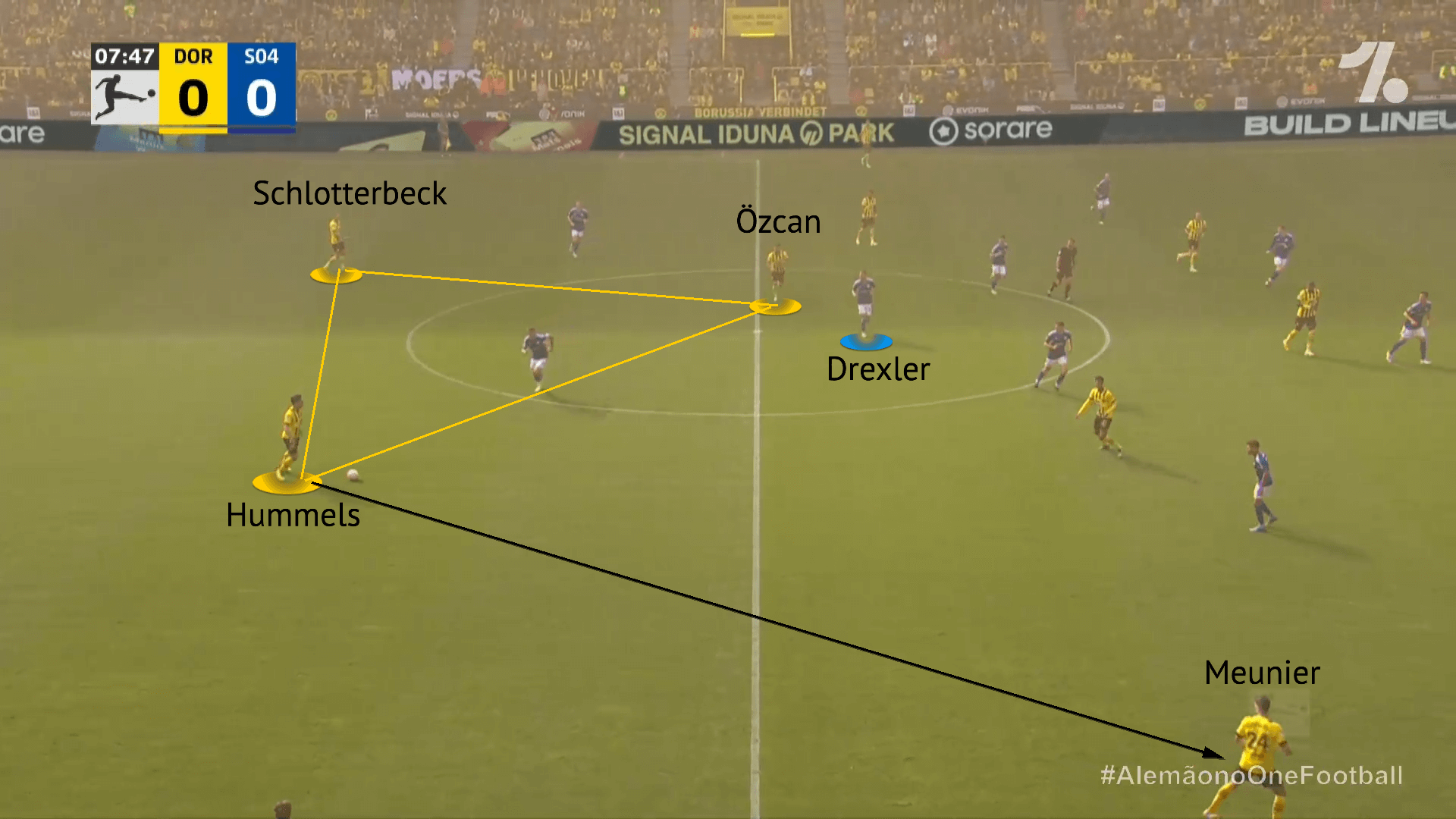




Comments